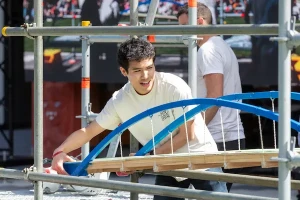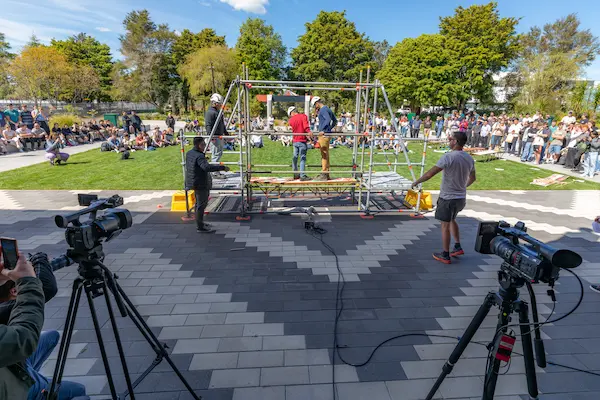 On display were solutions Waikato students have developed to address some of New Zealand’s gnarliest problems from decarbonising manufacturing processes, to early warning systems to manage landslides, and harnessing energy from our coastlines - protecting vulnerable communities in the process.
On display were solutions Waikato students have developed to address some of New Zealand’s gnarliest problems from decarbonising manufacturing processes, to early warning systems to manage landslides, and harnessing energy from our coastlines - protecting vulnerable communities in the process.
School of Engineering Senior Lecturer Dr Tim Walmsley says New Zealand currently only trains about 1800 engineers per year, and we need 2500 to keep pace with development.
Waikato now has 800 engineering students, up from about 300 in 2010, and Dr Walmsley says interest is increasing as more schools, parents and high school students discover Waikato’s engineering programmes.
"The Engineering Design Show demonstrates how engineers shape the world around us and serves to inspire the next generation of problem solvers that Aotearoa needs by showcasing our amazing students’ research, development and design projects," Dr Tim Walmsley.
The Government’s National Infrastructure Agency will launch in December, with the Infrastructure Commission also expected to deliver a National Infrastructure Plan setting out a roadmap for New Zealand’s infrastructure over the next 30 years.
“As New Zealand looks to decarbonise our economy, build our resilience to climate change and improve and grow our infrastructure, including our roading and three waters, we need more engineers to do the work,” says Dr Walmsley.
“At Waikato we emphasise and provide hands-on, industry-connected experience for our students from first to fourth year, and the Engineering Design Show showcases their tenacity and creativity to tackle real-world challenges, enabling them to launch a meaningful career,” says Dr Walmsley.
Some of the student projects at this year’s show included:
-
Digital twin technology being developed to improve energy efficiency in industrial processing and manufacturing; critical technology as New Zealand looks to decarbonise its industrial processes and address an energy crisis.
-
The development of a landslide early warning system designed to protect vulnerable communities. Landslides currently cost New Zealand about $250 million every year. The cost of landslides from Cyclone Gabrielle is estimated to be around $1.5 billion.
-
The design of energy-generating systems to harness the power of waves and currents along our coastline to generate renewable energy and protect vulnerable communities from coastal erosion and inundation in the process. This project looked specifically at coastal marae around New Zealand.
-
A review of farming methods on New Zealand’s peatlands to help farmers find economically viable alternatives to present land use. Currently many of Aotearoa’s peatlands are drained to be used for grazing and cropping, destroying their natural state. In New Zealand, degrading peatlands are releasing six percent of agricultural CO2.
-
An apple-picking robot designed to help address labour shortages in New Zealand’s horticultural industry.
Students have also been involved in the building and launch of a rocket designed to fly 3000 metres in the air and the development of an electric vehicle that will be raced in Australia in November as part of the formula SAE-A international student engineering design competition, organised by the Society of Automotive Engineers – Australasia. The Waikato team won the ICE title in 2022 and are returning this year with an electric vehicle built by fourth-year mechanical, mechatronics and software engineers.




